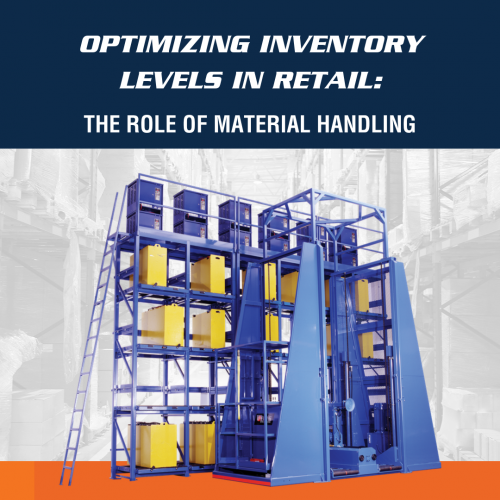We use cookies to make your experience better. To comply with the new e-Privacy directive, we need to ask for your consent to set the cookies. Learn more.
Optimizing Inventory Levels in Retail: The Role of Material Handling

Matching inventory to demand is always a challenge in retail. Too much, and you hemorrhage money in storage and handling costs. Too little, and you miss out on make-or-break opportunities.
The trouble is, an optimal inventory level is always a moving target. As we write this, there seems to be some anxiety regarding retail inventory at the national level. The August 2019 Non-Manufacturing ISM® Report On Business® from the Institute for Supply Management showed a 4.5-percentage-point decline in Inventory Sentiment. Company decision makers, the Report suggests, feel that their inventory levels are too high.
The danger here is that retail companies will overcorrect, allowing inventory levels to run low just in time for the holiday purchasing onslaught. Too much or too little; either way, we’re looking at lost revenues and higher costs for retail operators.
The business press is stuffed with inventory management strategies that can help retailers make wise decisions about how many goods to keep on hand. But what few strategists discuss is the unique role material handling can play in softening the impact of inventory misfires.
That’s right; the ideal material handling strategy can expand the window of success between too few goods and too many.
How? Well, improve your material handling systems to...
Optimise warehouse space…
Storage costs are a big part of the urge to keep inventory levels no higher than necessary. So what if you could use existing warehouse space more effectively, attaining the highest value-per-square-inch out of your warehousing dollar?
The key for most storage operations is to successfully use the whole cube, including sometimes-neglected vertical space. We’ve written about the best ways to do that here on this blog before, but be sure to look for space-saving changes everywhere in the warehouse, and not just in the aisles.
For instance, warehouse that run electric forklifts can limit battery-room size considerably by choosing a Quad Stack Battery Extractor system to slash battery storage, charging, and change-out space requirements.
Use more cross-docking for order fulfillment...
Cross-docking — breaking incoming shipments down into outgoing orders without storing items at all, or with minimal storage — takes the strain out of inventory management by side-stepping it entirely.
Cross-docking can cut transportation costs and improve order turnaround times at once. Granted, this approach typically shows its strength further upstream the distribution channel, but it can be ideal for general-purpose retailers.
A flexible cross-docking system allows shippers to consolidate less-than-load shipments into full trucks, fulfilling multiple custom orders at once. This requires workers to break down pallet loads and rebuild the orders, all of which is safer and more efficient with ergonomic palletizing stations.
Reduce warehousing costs across the board…
The fact is, material handling costs are a significant portion of the total price of holding inventory. The more you can reduce those costs, the less the occasional period of overstock will impact your total operation.
Advanced material handling equipment can reduce ergonomic injuries, lowering labor costs and insurance payments. They can boost productivity in the warehouse and the distribution center. And, by accomplishing these and other goals, they can cut total costs for storage and logistics.
Given the complex, ever-shifting nature of an optimal inventory level for a retail operation, it’s wise to cut the costs of holding and shipping inventory as much as possible. That’s where better material handling comes into play.
References:
“August 2019 Non-Manufacturing ISM® Report On Business®.” InstituteForSupplyManagement. Institute for Supply Management, 5 Sept. 2019. Web. 14 Sept. 2019.
